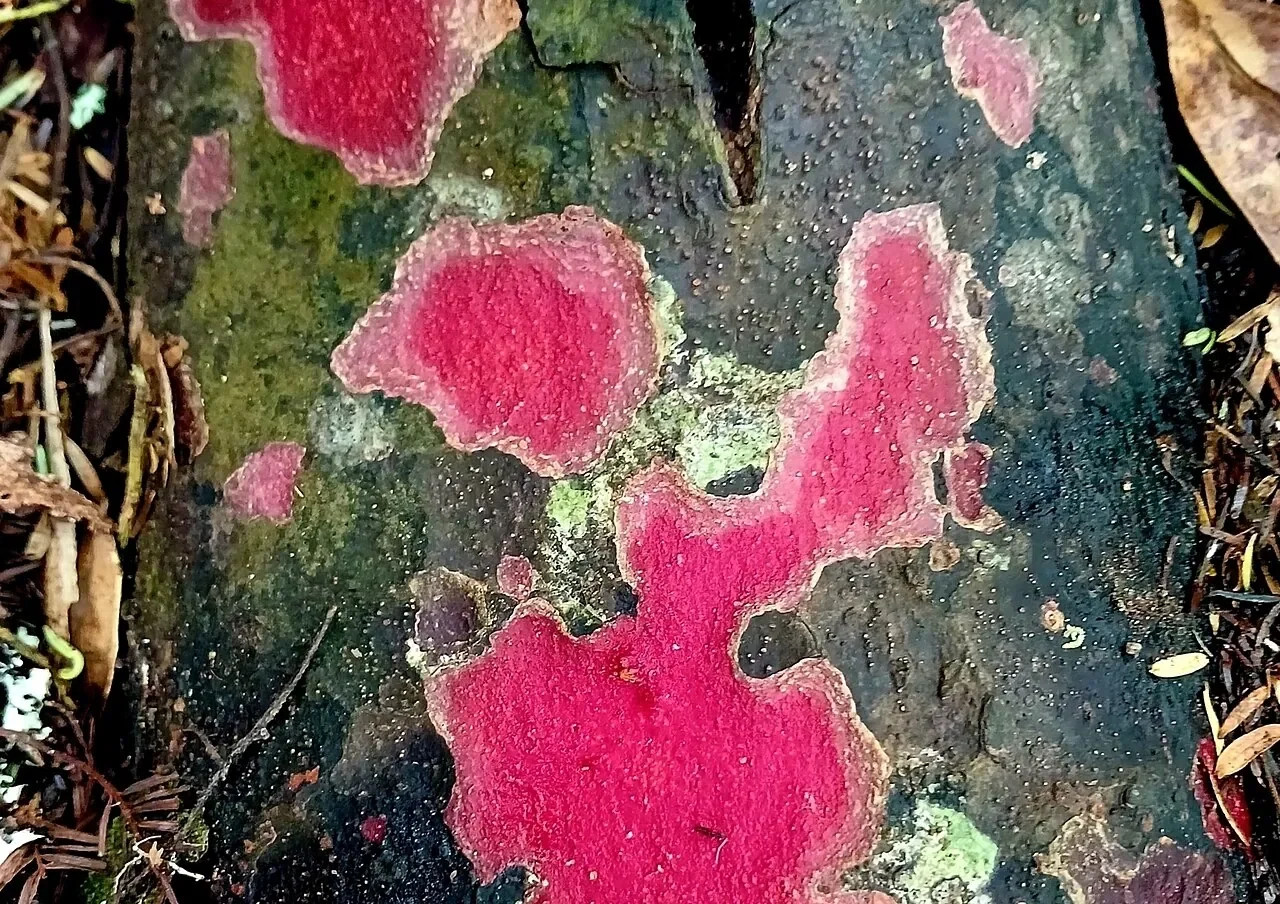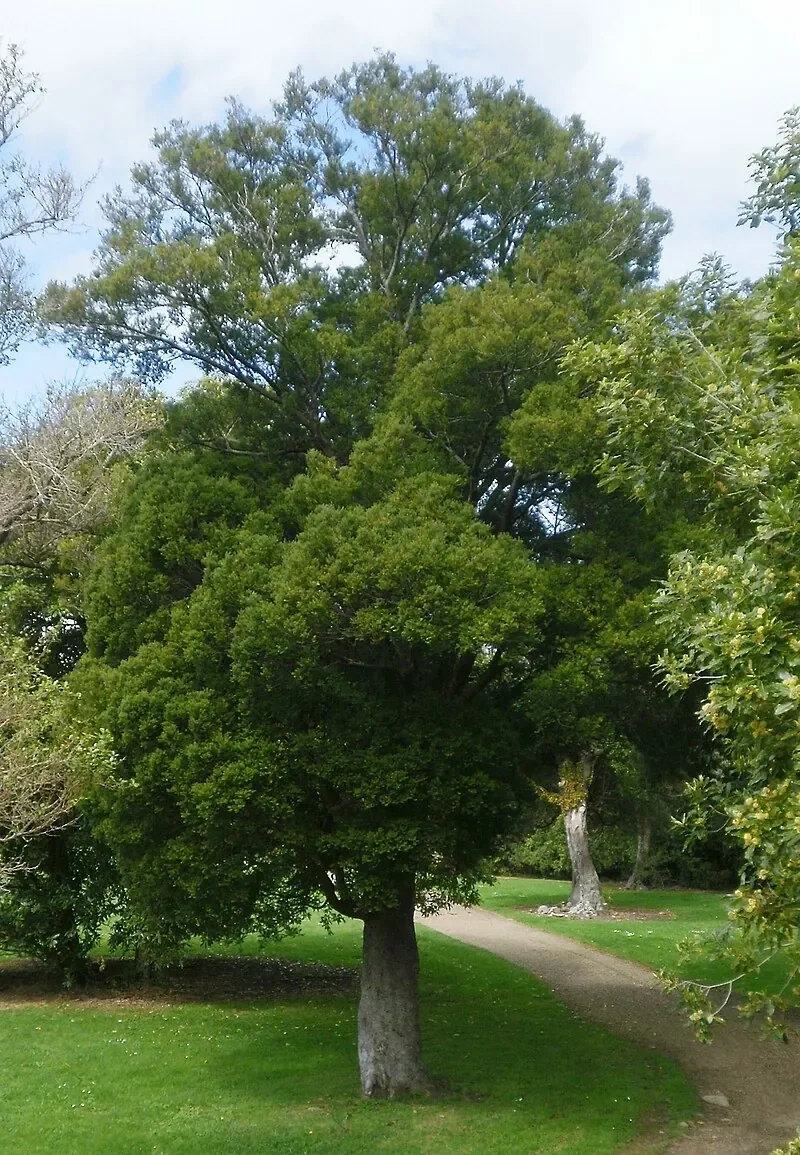
Mataī
Prumnopitys taxifolia
Introduction
Introduction Overview
Mataī ( Prumnopitys ) is a medium-sized native New Zealand conifer with dark, rounded leaves and blue-black fruit. It is valued for its timber and as a food source for native birds. native trees .

Plant Description
Botanical Features
Mataī ( Prumnopitys taxifolia ), also known as black pine, is a dioecious evergreen conifer endemic to New Zealand. It is a tall forest tree that can reach heights of up to 30 meters with a trunk diameter of 1-2 meters, and has an average lifespan of 600 years, potentially living up to 1000 years. The bark is thin and smooth on younger trees, developing into a dark brown to almost black colour with age, and peels freely in thick, circular flakes, leaving a distinctive "hammer-mark" pattern. Mataī exhibits profound heteroblasty, meaning its juvenile and adult forms are distinctly different. For up to 60 years, it appears as a tangled, wiry shrub with slender, flexible, divaricating branchlets and small, brown, pale yellow, or dirty white leaves. The adult leaves are dark green, linear (10-15 x 1-2 mm), and arranged spirally. As a dioecious species, male and female reproductive structures are found on separate trees. Male cones are found in spikes, while the fruit is a fleshy, oily, aromatic, purple-black drupe with a glaucous bloom, approximately 10mm in diameter, containing a single seed. These berries are a food source for native birds like the Kererū.
Quick Facts
Quick Facts Overview
| Scientific Name | Prumnopitys Taxifolia |
|---|---|
| Height | Up to 25 m |
| Spread | 8-12 m (broad crown at maturity) |
| Water Needs | Moderate; prefers moist, well-drained soil |
| Light | Full sun to partial shade |
| Frost Tolerance | Moderate (tolerates light to moderate frost) |
| Salt Tolerance | Low (not tolerant of coastal salt) |
| Growth Rate | Slow to moderate |
| Lifespan | Very long -lived (hundreds of years) |
Climate Best Suited to
Prumnopitys is native to New Zealand and thrives in the country's diverse climate conditions. It adapts well to various regional climates throughout the country.
Regional Suitability
| City | Climate Suitability |
|---|---|
| Whangārei | Ideal |
| Auckland | Ideal |
| Hamilton | Ideal |
| Tauranga | Ideal |
| Rotorua | Ideal |
| Gisborne | Ideal |
| New Plymouth | Ideal |
| Napier | Ideal |
| Whanganui | Ideal |
| Palmerston North | Ideal |
| Wellington | Ideal |
| Nelson | Ideal |
| Christchurch | Ideal |
| Dunedin | Ideal |
| Invercargill | Ideal |
Natural Habitat
Natural Habitat Overview
Prumnopitys is naturally found in specific habitats throughout New Zealand. Understanding its natural environment helps in providing appropriate growing conditions in cultivation.
Plant Conservation
Conservation
Prumnopitys taxifolia , commonly known as mataī or black pine, is a species of tree endemic to New Zealand. It is a long-lived conifer, reaching up to 30 meters in height and living for an average of 600 years, with some specimens reaching 1000 years. Despite historical logging that significantly reduced mataī-dominated forests, its current conservation status is "Least Concern" according to the IUCN Red List (assessed in 2013) and "Not Threatened" by the New Zealand Threat Classification System (assessed in 2023). However, while not currently threatened, its habitat remains vulnerable to loss and degradation due to activities like logging and land development. Very few intact examples of mataī-dominated forest remain. Conservation efforts focus on protecting mature trees, controlling pests, and restoring native forest habitats to ensure the long-term survival of this species. Individuals can contribute to conservation by supporting efforts to protect native forests, opposing activities that threaten these ecosystems, and promoting sustainable forestry practices.
Soil Requirements
Prumnopitys prefers well-draining soil with good organic content. It can adapt to various soil types but performs best in loamy or sandy soils.
Water Needs
Prumnopitys requires moderate watering, especially during establishment. Once established , it becomes more drought-tolerant.
Light Requirements
Prumnopitys grows best in full sun to partial shade, depending on the specific species and local climate conditions.
Temperature
Prumnopitys is well-adapted to New Zealand's temperate climate and can tolerate both warm summers and cool winters.
Planting Guide
When to Plant
Best planted in autumn or spring when soil moisture is reliable.
Site Selection
- Choose a site with deep, fertile, well-drained soil.
- Full sun to partial shade is ideal.
Planting Procedure
- Remove weeds and prepare the soil.
- Dig a hole twice the width of the root ball.
- Plant at the same depth as in the pot.
- Backfill and firm gently.
- Water in well and mulch to retain moisture.
Ecological Value
Wildlife Support
Mataī provides food and habitat for native birds and insects, contributing to forest biodiversity. Its berries are a key food source for kererū and other wildlife, supporting healthy forest ecosystems.
Uses and Applications
Practical Applications
Prumnopitys has various practical and ornamental uses. From traditional Māori applications to modern landscaping, this versatile plant serves multiple purposes.
Historically, Prumnopitys was used by Māori for medicinal purposes, food, and cultural practices. These traditional uses reflect the deep knowledge of native plants.
Landscaping Uses
Garden Design
Mataī is an excellent choice for large gardens and extensive restoration projects, where its impressive stature and longevity can be appreciated. It is often effectively planted as a majestic specimen tree, or integrated into mixed native plantings to create a naturalistic forest aesthetic.
Seasonal Care Calendar
Spring
- New growth appears; apply mulch and check for weeds.
Summer
- Water young trees during dry spells; monitor for pests.
Autumn
- Collect fallen fruit for propagation; remove dead leaves.
Winter
- Protect young trees from frost; minimal care required for mature trees.
Pruning
Pruning Techniques
Mataī requires minimal pruning. Remove dead , damaged, or crossing branches in late winter or early spring to maintain shape and health. Avoid heavy pruning, as this can stress the tree.
How to Grow Mataī
Mataī is a medium-sized native New Zealand conifer with dark, rounded leaves and blue-black fruit. It is valued for its timber and as a food source for native birds. This resilient and ecologically important tree adds a touch of primeval grandeur to any landscape, showcasing the ancient lineage of New Zealand's conifers. Understanding its propagation methods is key to successfully growing this delightful species.
From Seed
Propagating Mataī from fresh seed is a viable method, though germination can be slow and may require stratification. Collect ripe fruit in autumn. Remove the fleshy coating from the seeds and sow them in a free-draining mix. Germination can be slow and may require stratification (chilling). Maintain consistent moisture in the seed tray and keep it in a warm, sheltered location. Germination can take several weeks to months. Once seedlings have developed a few true leaves, they can be potted into individual containers and grown in a sheltered environment before planting out.
From Cuttings
Vegetative propagation of Mataī from cuttings is rarely used and can be challenging. Semi-hardwood cuttings may be attempted in late summer, but success rates are generally low. If attempting cuttings, use rooting hormone and maintain consistent humidity and warmth. This method is best suited for experienced propagators or in specialized nurseries for conservation purposes.
Pests and Diseases
Common Pests
Prumnopitys is generally resistant to most pests due to its native adaptations. However, it may occasionally be affected by common garden pests such as aphids or scale insects.
Disease Prevention
To prevent diseases, ensure good air circulation around Prumnopitys and avoid overwatering. Remove any diseased plant material promptly to prevent spread.
Cultural Significance
Cultural Importance
Mataī Timber Heritage
Mataī provided durable flooring and joinery timber and remains an emblem of lowland podocarp forests; its fruits are important to native birds and forest cycles.
Prumnopitys taxifolia , commonly known as Mataī, holds significant cultural importance, particularly for the Māori people of New Zealand. Mataī wood was traditionally used by Māori for carving, building, canoes, canoe bailers, small agricultural implements, and handles, especially in areas where totara was less common. The seeds of the Mataī tree were an important food source for Māori. Various parts of the Prumnopitys plant, including Mataī, were historically used for medicinal purposes. The liquid from cracks in the heartwood, sometimes referred to as "mataī beer," was consumed to treat consumption and as an antiseptic. Mataī carries spiritual and cultural significance, symbolizing strength and resilience. It was also incorporated into traditional ceremonies and practices. Individual Mataī trees could serve as tribal landmarks and were considered to possess special powers of tapu (sacredness). A notable example is Hinehopu's tree, a large Mataī that became a significant landmark for the Ngāti Pikiao tribe.
Bonus Tip
Expert Growing Advice
Mataī ( Prumnopitys taxifolia ) exhibits a fascinating phenomenon called heteroblasty, where its juvenile form is distinctly different from the adult. For up to 60 years, it appears as a tangled, wiry shrub with small, brown, pale yellow, or dirty white leaves. This dramatic change in appearance led early botanists to mistakenly believe the juvenile and adult forms were separate species.







